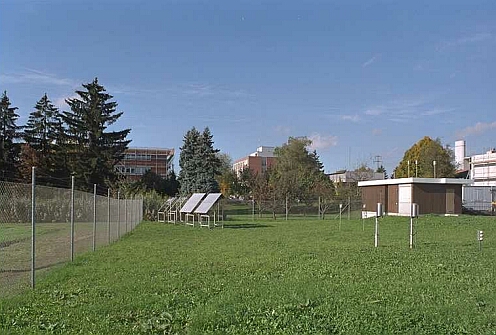12th Science Apéro at the EMPA Academy
Do you really know what you're breathing?
Every day we spend about 20 hours indoors. An important factor in our well being during this time is the quality of the air that we breathe. Our nose lets us know very quickly if it is not fresh. Exactly what is in the air we breathe was the subject of three presentations at the latest Science Apéro on June 30th at the EMPA Academy.

|
Under the title «This building is making me ill!» Roger Waeber of the Swiss Federal Office of Public Health (BAG) described the various sources of health-endangering chemicals which contaminate room air. Building materials, impregnated furniture and certain household products are all candidates in this respect. Very often, in Switzerland at least, a change of tenant means time for renovating the premises, and to minimize the loss of rent this has to be done at lightening speed. This means that the solvents and other volatile materials used for the job do not have time to dissipate completely and so slowly percolate into the room air. Adhesives used for DIY purposes emit pollutants too, and even a burnt sausage plays a role by releasing soot into the air. Needless to say, tobacco smoke is also a significant cause of poor quality indoor air.
Toxicological evaluation of individual pollutants of limited use In evaluating the consequences in specific cases, Waeber informed us that the important questions to ask is to what extent was the victim exposed to which pollutant. This data is important because depending on the sequence of events and the characteristics of the compound in question it is possible that other exposure paths exist, not just via the air. If this is the case, then regular airing of the rooms or buildings in question will not be enough to allay the problem. Toxicological evaluation of individual pollutants is also inadequate if inhabitants complain of mostly unspecific health problems, and in such cases a global appraisal of the poor air quality is necessary. This is exactly what Hartmut Frank, Professor of Environmental Chemistry and Eco-toxicology at the University of Bayreuth, Germany, does. Little work has been done in the field of air hygiene on the combined effects of several pollutants, a procedure, which is well established in, for example, pharmacology. This is despite the fact that the question of air quality has been a concern right from the very beginning of the industrial revolution. The pollution of the atmosphere through the burning of fossil fuels and the release of hydrogen sulfide from piles of rotting garbage, both of which had serious negative effects on the health of the general population over the past few centuries, are two examples of problems which have been successfully overcome. The air quality, and thereby also the quality of life of the inhabitants of Europe’s cities, has continually improved as a result of pollution measurement and the consequent legal counter-measures. It must be said, though, that the monitoring of air quality has its problems too, and unreliable data can lead to erroneous conclusions. Toxins which appear only in minute concentrations but which still have serious effects may not be measured at all, leading to incorrect risk evaluation.
Improved risk evaluation through interdisciplinary cooperation Prof. Frank made a plea for interdisciplinary cooperation. In his opinion, only when many scientific disciplines work hand-in-hand on this subject would it be possible to fully understand and analyze the risks of air pollution. In addition to reliable emission monitoring, eco-toxicological investigations must be undertaken, data on deposition and resorption paths harmonized, the effects of pollutants experimentally evaluated and exposure limits defined. Martin Kohler, of EMPA’s Organic Chemistry Laboratory, then recounted the contributions, which he and his colleagues are making in this field. For example, EMPA together with the Swiss Agency for the Environment, Forests and Landscape (SAEFL) records air quality data via the NABEL Monitoring Network. In addition to known pollutants such as sulfur dioxide, whose concentration has been reduced through technical measures, persistent organic pollutants (POPs) are at the center of attention more and more frequently.
Persistent organic pollutants (POPs) POPs are transported great distances in the atmosphere, do not degrade and accumulate in the food chain. They can cause disturbances to the human endocrine system, neurological and developmental disorders, and are also believed to be carcinogenic. EMPA is investigating certain POPs, for example polychlorinated biphenyls (PCBs), which were formerly widely used as plasticizers in jointing mastic. In another investigation into the accumulation of bromated flame retardants, EMPA research demonstrated that certain flame retardants (PBDEs) which are used for impregnating foams and textiles, accumulate in fish in Swiss lakes. It is believed that the compounds are transported principally through the atmosphere before entering the food chain.
Technical information: Dr.
Martin Kohler, Organic Chemistry Laboratory, |
||
